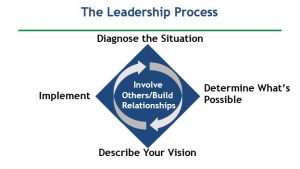Leadership is a Process!

Leadership
February 18, 2021
Paul B. Thornton
Author, Speaker, and Adjunct Professor
Topics
build relationships, Involve others, Leadership, leadership process, Passion in leadership, Processes, status quo, VisionWhat do you do at each step in the process?
The diagram below highlights the steps involved in the leadership process. Throughout the process, leaders involve people and build relationships.

1. Diagnose the Situation
What’s going on?
Leaders are open, curious, and motivated to get a full understanding of the current situation. Organizations and markets are complex and constantly changing. You have to review a lot of data, decide what’s relevant, and create a clear picture of the current situation.
Tips for diagnosing the current environment
- Make a list of all significant changes. Consider how they are impacting your customers and employees.
- Get feedback from multiple points of view. Bring in new employees, consultants and use secret shoppers to get a fresh perspective.
- Analyze the hard data, the numbers, and the soft data, people’s feelings and emotions.
- Consider what working well (successes) and what areas are performing below expectations.
- Create diagrams to help understand the informal network and key relationships.
Don’t surround yourself with “yes people.” You want people who will challenge assumptions, pose tough questions, and give honest assessments.


2. Determine What’s Possible
What do people need at the current moment? Hope? Calmness? Clear priorities? Encouragement? A time-out?
Deal with the immediate issues before addressing the bigger question—What’s possible going forward?
What Is What’s Possible

When you identify what’s possible, it creates hope, energy, and excitement.
Will you always have a clear view of what possible? No, of course not! In most cases, discussions with your colleagues and teams are required. Through collaboration, you identify the best opportunities to consider.
Tips for identifying what’s possible
- Study the best performers. They always provide some useful insights.
- Increase your curiosity. Seek out new questions to explore.
- Brainstorm. Work with a diverse, cross-functional group of people and create a list of potential opportunities.
- Travel. Observe the different approaches businesses use in other countries.
- Ask the big questions. How could we increase sales by 10X? What can we do to change the game?
You don’t have the time, people, money, and energy to pursue every opportunity that’s identified. So, prioritize the best one-to-three ideas to pursue.

3. Describe Your Vision
Use words and pictures to describe your vision. Connect with people at both the rational and emotional levels. Facts and logic can be persuasive. How people feel about the facts can be energizing.
Present a compelling case as to how your ideas and plans will improve current situation.

- Use words that are simple, visual, and concrete.
- Create pictures that have the right amount of detail.
- Explain the WIIFT—what’s in it for them. How will people benefit from your idea?
- Help people see themselves operating in the new environment.
- Deliver your message with passion and conviction.

4. Implement
First, establish a project team to create a detailed plan. The plan should include all required changes including the actions needed to increase people’s ability and motivation to do what’s required.
The project team should include a project manager, some members of the target group (those people directly impacted by the changes), some members of the support group (people who can help the target group), and other influential people. When the right people are involved in creating the plan, they are more committed to making it a success.
Tips for a successful implementation
- Assign specific roles and responsibilities.
- Define the metrics you will use to measure progress.
- Create opportunities for early successes. Build momentum.
- Expect resistors. Listen to what they have to say but keep moving forward.
- Praise individuals and hold team celebrations.
- At regular intervals, provide up-to-date information on progress and problems.
Change is stressful, messy, and full of surprises. You need to be flexible and make adjustments as needed. The goal is alignment. Get everyone on the same page pursuing a set common set of goals.
You need a team of mutually committed individuals to make big things happen.
Involve Others & Build Relationships
In the middle of The Leadership Process diagram are the words “Involve Others/build Relationships.” This should be happening at each step in the process.
- Involve others—solicit people’s ideas and opinions. Collaborate. Most employees are thrilled when asked for their opinion.
- Build relationships—get to know your people—their interests, family, key accomplishments, frustrations, and career goals. And, let them get to know you—your beliefs, values, family, successes, and proudest moments.
Tips for involving others and building relationships
- Check-in on a regular basis.
- Always be respectful.
- Ask more questions—why, why not, what if, and what else.
- Listen and don’t interrupt.
- Recognize their efforts and accomplishments.
- Open up and share what you are thinking and feeling.
Involving people in each step of the leadership process increases their ownership and commitment to improving the status quo.
Summary
Leadership is a process!
Each step is important and requires you to take specific actions to be successful.
Paul B. Thornton is an author and speaker. His latest e-book, Leadership-Perfecting Your Approach and Style-($1.99) is available on Amazon Kindle.
He has produced 28 short YouTube videos on various management and leadership topics.
He can be contacted at pthornton@stcc.edu.






